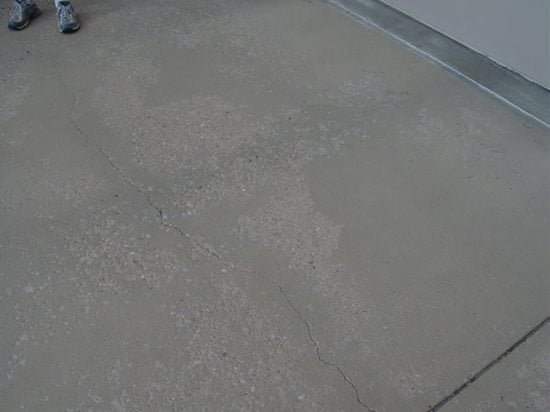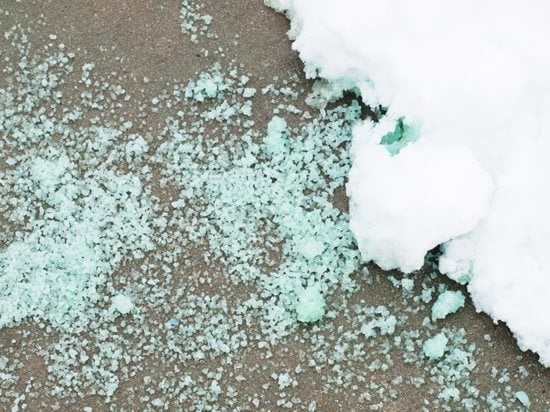- Staining Concrete
- Stamped Concrete
- Concrete Overlays
- Concrete Resurfacing
- Concrete Polishing
- Concrete Dyes
- Colored Concrete
- Indoor Concrete
- Concrete Floors
- Concrete Countertops
- Garage Floor Coatings
- Furniture, Sinks, Fire Bowls
- Basement Floors
- Outdoor Concrete
- Concrete Patios
- Concrete Driveways
- Concrete Pool Decks
- Outdoor Kitchens & Counters
- Outdoor Fireplace
- Concrete Walkways
- Concrete Pavers
- Concrete Walls
- Repair & Maintenance
- Foundation Repair
- Concrete Crack Repair
- Concrete Sealers
- Building with Concrete
- Concrete Homes
- Concrete Basements
- Decorative Concrete
- Fire Resistant
How to Melt Ice Without Damaging Concrete
Learn what ice melts are safe to use on concrete and won't cause winter salt damage.If you are the owner of a new concrete driveway or sidewalk and you live in a cold climate, it’s time to reconsider the methods you use to melt ice and snow. Rock salt (sodium chloride) is often the first deicing agent homeowners turn to because it’s inexpensive and effective. However, it’s very corrosive and can do significant damage to concrete surfaces and even pose a threat to pets and plant life.
Find concrete contractors near me
Fortunately, there are many other deicing methods and products you can use that work just as well and won’t ruin your concrete. You can also take a proactive approach and protect your concrete before winter weather arrives by preventing exposure to harmful road salts and freeze-thaw damage. Here’s a look at a some of your options.
Use safer deicing chemicals
Instead of resorting to rock salt, you can choose from a wide array of commercial ice melt products that are less corrosive and safer for the environment. Because most deicing chemicals increase freeze-thaw cycling (which can lead to spalling), you should avoid using deicers on concrete the first winter after it’s placed. Concrete less than a year old has significantly less freeze-thaw resistance than mature concrete.
- Of all the concrete deicers on the market, calcium chloride will melt ice the fastest and it remains effective at temperatures as low as -25º F, compared to the 15º to 20º F range at which rock salt is effective. It also won’t harm your lawn or other plant life when used as directed.
- Potassium chloride and magnesium chloride are also good ice melt options for concrete that are plant-safe and less corrosive. Potassium chloride begins to lose its effectiveness at temperatures below 25º F, so it’s not a suitable option for really cold days. Magnesium chloride is faster-acting and effective down to -13º F.
- Calcium magnesium acetate (CMA) is a chloride-free concrete deicer combining dolomitic lime and acetic acid (the principle component of vinegar). CMA is fully biodegradable, will not harm vegetation, and is non-corrosive. Instead of liquefying ice and snow like salt does, it interferes with the ability of snow particles to adhere to the concrete surface, allowing ice and snow to be removed more easily. CMA is usually more expensive than other deicer options, but it’s the only product safe for use on newer concrete.
- Beet juice salt is the newest option for treating snow and ice covered concrete. Because the sugar from the beets lowers the freezing point of ice, this product is very effective at low temperatures. Beet juice deicer also has natural anti-corrosion properties, making it safe for use on concrete.
Tip: If possible, pretreat your concrete walkways and driveways with a light application of ice melt before a winter storm arrives. This will help reduce ice buildup and minimize the amount of deicer you’ll need to use later.
Apply an abrasive
Applying an abrasive material, such as sand or natural volcanic granules, to an icy concrete driveway or sidewalk is great for improving traction and making surfaces safer. Although these abrasives won’t actually melt ice or snow, you can use them in combination with deicing chemicals, if necessary, to reduce the amount of deicer you need to apply and lessen its negative impact.
Install a heated driveway
Before installing a new concrete driveway or sidewalk, consider investing in an in-slab electric or hydronic heating system, which can eliminate the buildup of ice and snow and the need for deicing chemicals. These heating systems are quite expensive to install, but once in place, they eliminate plowing, shoveling, ice formation, and potential damage to concrete caused by snow-removal equipment and corrosive deicers.
Lay down snow-melting mats
For existing concrete pavements, a good alternative to an in-slab heating system is to lay down snow-melting mats that plug into a standard 120-volt outlet. These systems come in various sizes to heat concrete stairs, walkways, entrances, or the wheel paths of a driveway. Not only do they continuously melt ice and snow, they have textured surfaces to improve traction. When not in use, you can simply roll them up and store them in a garage until needed.

If your concrete isn’t protected with a sealer, it could end up with ugly pits caused by freezing and thawing and exposure to salts.
Seal your concrete against moisture and salt intrusion
Even if you don’t apply harmful deicing salts to your concrete driveway, it can be exposed to deicers used by road snow-removal crews if the snow is plowed onto the apron of your driveway or clings to the underside of your car. In areas with severe winters, it’s wise to seal your concrete against moisture and salt intrusion as extra insurance against corrosion and freeze-thaw damage.
For maximum protection, use a penetrating sealer designed to limit the intrusion of moisture and chlorides into the pores of the concrete. Examples include Intraguard from W.R. Meadows, and Gem-Guard SB from Brickform.
What if my concrete already has salt damage?
Over time, salt can damage concrete and lead to discoloration, cracking or a crumbling surface. Depending on how severe the damage is, you may be able to fix your concrete. There are a variety of concrete repair options, as well as concrete resurfacing to create a fresh, new surface.
RELATED:
Pouring Concrete in Cold Weather
Maintaining Concrete





